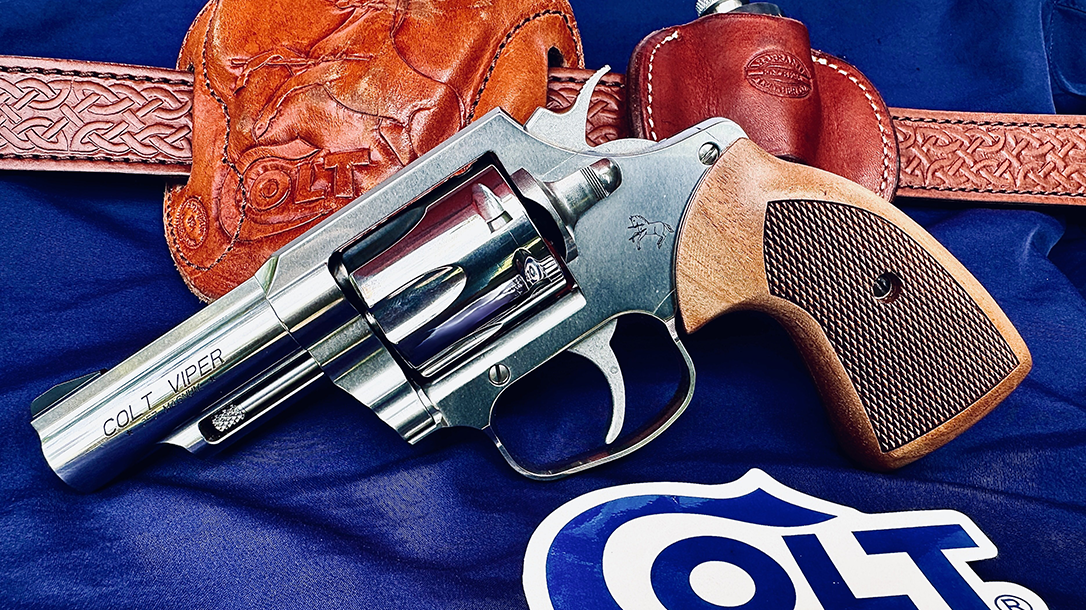One of the rarest Colt D-frame, double action (DA), swing-out cylinder revolvers was the Viper. It was an update of the Police Positive Special, but had an aluminum frame, and was chambered in .38 Special. It was styled like the post-1972 Detective Special, but had a 4-inch barrel, and was available in blue or nickel finish. They were only made in 1977—hence the rarity. Now Colt brings back the Viper in .357 Magnum, and it’s every bit as good as the first.
Colt Viper 357: The Comeback Kid
Colt returned to the concealed carry revolver scene in 2017 with the Cobra. Unlike the original aluminum-frame model, this new version had a stainless-steel frame, plus some notable design changes. However, it retained the .38 Special chambering and 2-inch barrel.
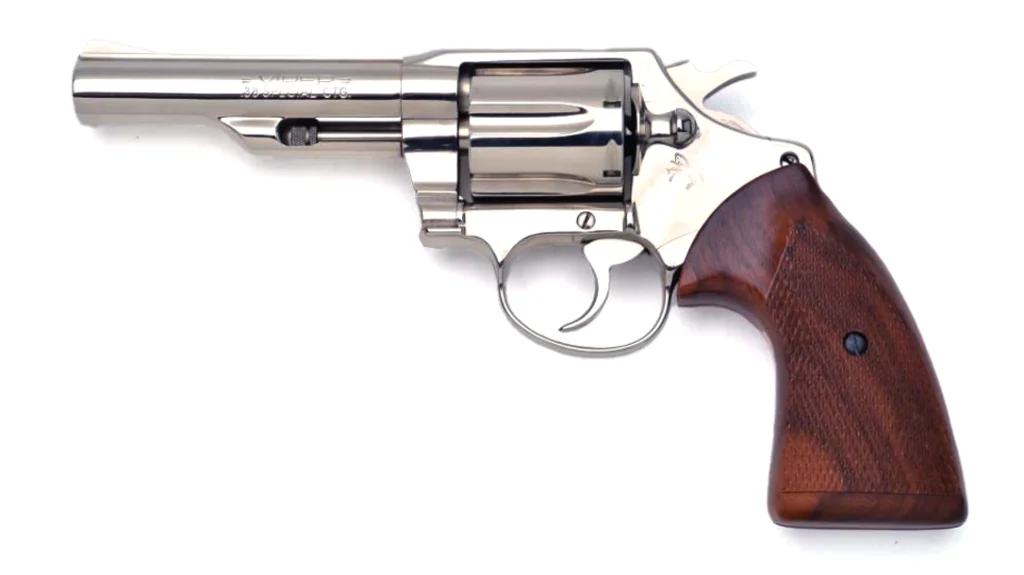
Advertisement — Continue Reading Below
Colt built on that model, adding the King Cobra series, with versions in .357 Magnum. They had fixed sights and 2- or 3-inch, full-lug barrels. Then, Target versions were added in .357 and .22LR, with adjustable sights and 4.25-inch barrels.
Now Colt has resurrected the Viper moniker and attached it to a similar stainless-steel 6-shot, fixed-sight .357 Magnum revolver with a 3- or 4.25-inch barrel. What is different about the Viper is that it has a half-lug under the barrel protecting the ejector rod. Likewise, it has traditional walnut stocks, like those on the original Viper.
I’ve always had a thing for 3-inch barrel wheelguns, and years ago, I carried one as a law enforcement officer. To me, it is a very versatile barrel length, allowing it to be used for both on and off-duty carry. Naturally, I requested a 3-inch version of the Viper for testing and evaluation.
Advertisement — Continue Reading Below
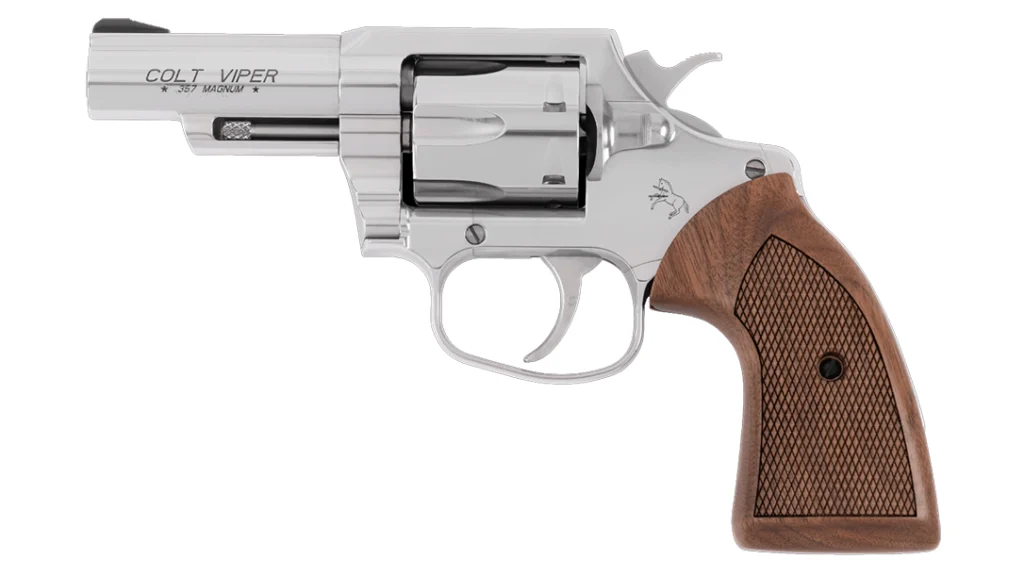
My sample gun came in a Colt blue plastic carrying case with a foam-rubber padded interior, an owner’s manual, and a safety padlock. An inspection of the Viper from muzzle to butt revealed outstanding metal-to-metal and wood-to-metal fit. Likewise, it had no blemishes on the natural, standard-polish, stainless-steel finish.
The top of the barrel rib and frame top strap have a matte finish. Colt has standardized on a short grip frame like the one once found on the D-frame Agent revolver. The walnut stocks extend almost an inch below the frame. They are nicely checkered with light coloration and little grain.
Advertisement — Continue Reading Below
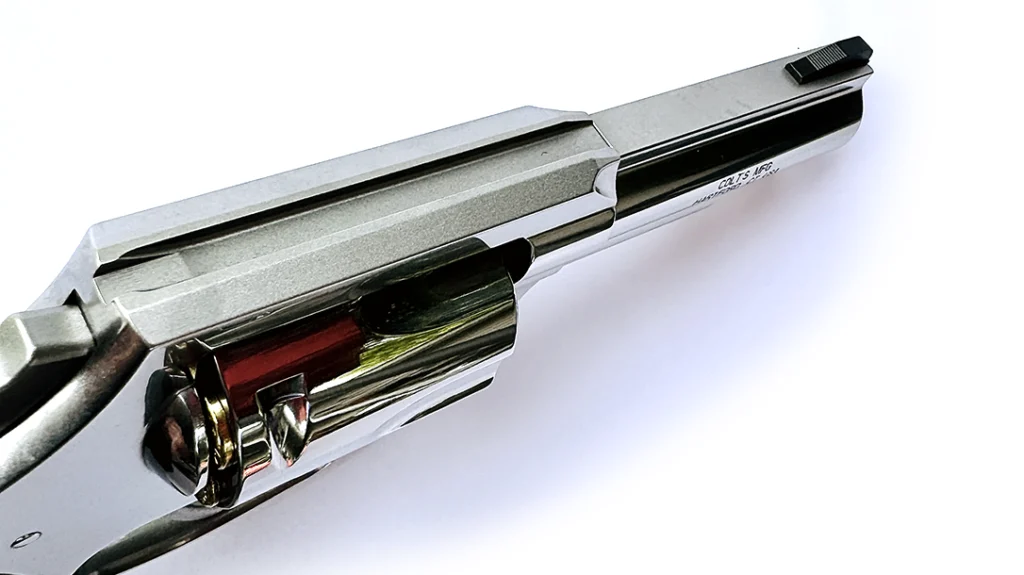
A Smooth Operating Wheelgun
Unlike the King Cobra, the Viper’s front sight is a black, serrated ramp, which is held in place by a tiny torque screw. The square-notch rear sight is 0.15 inches wide and offers a good sight picture.
Its heavy barrel has 1:14” LH, 6-groove rifling, with a recessed muzzle crown. The 3-inch barrel allows for a full-length ejector rod, this one is checkered at the tip. The beefy frame has a thick top strap and should hold up well, even with a steady diet of .357 Magnum cartridges.
Advertisement — Continue Reading Below
Like all Colt round guns, the cylinder rotates clockwise, is fluted, and chamfered on the front edges between the flutes. Pulling backward on the cylinder release latch frees the cylinder to swing out to the left for loading.
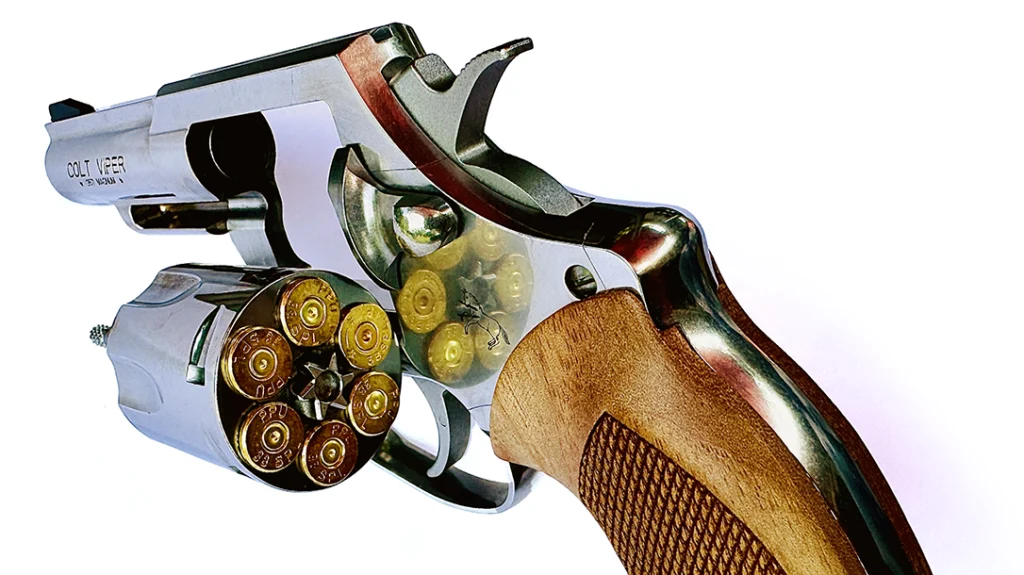
The hammer spur is serrated, and the trigger is about 0.25-inch wide and smooth-faced. The single-action (SA) trigger pull averaged 4 lbs. 1.9 oz., with no creep, while the DA pull weighed 8 lbs. 13.5 oz., was non-stacking, and smooth. This can be attributed to the gun’s double-leaf V-spring.
Advertisement — Continue Reading Below
Setting Up for the T&E
The solid steel Viper weighs 26.9 oz empty. So, I wanted to shoot both .357 Magnum, plus standard velocity and +P .38 Special loads.
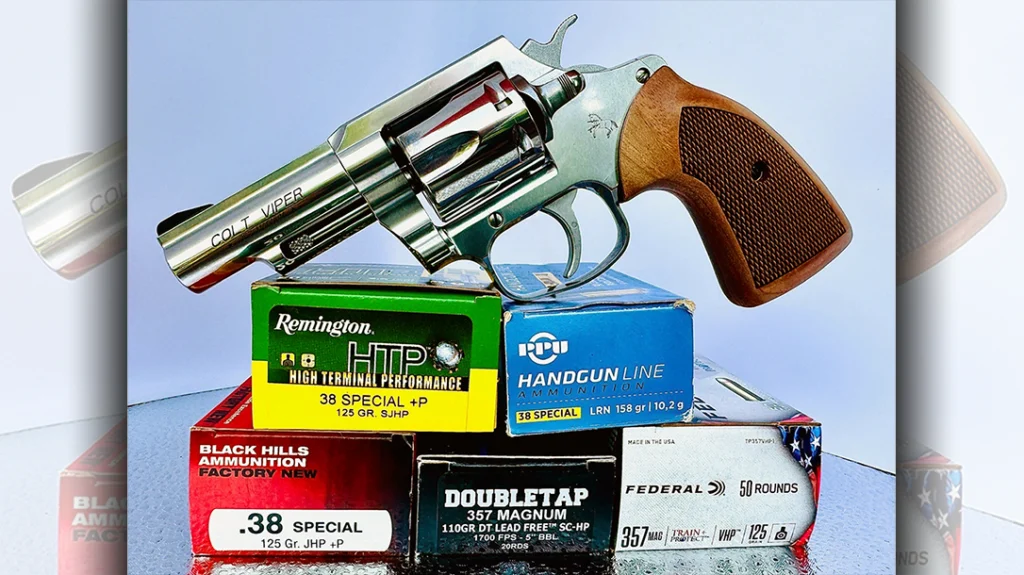
Black Hills provided me with their Factory-New .38 Special +P ammo, which has a 125 gr. JHP bullet. Doubletap sent me .357 Magnum cartridges, which are loaded with a 110 gr. solid-copper HP bullet. My other .357 Magnum load was Federal’s Train + Protect, which has a “Versatile” 125 gr. JHP bullet.
Advertisement — Continue Reading Below
My standard-pressure .38 Special load came from PPU in Serbia and has a 158 gr. LRN bullet. Remington shipped me its .38 Special HTP +P rounds, which have its famous 125 gr. semi-jacketed (scalloped) HP bullets.
For carrying leather, I used a well-worn Sourdough Pancake holster from Rob Leahy. It’s a high-ride, open-top style with three belt slots and fitted to the Colt D-frame. My shuck is tan in color with custom stamping depicting the Rampant Colt logo.
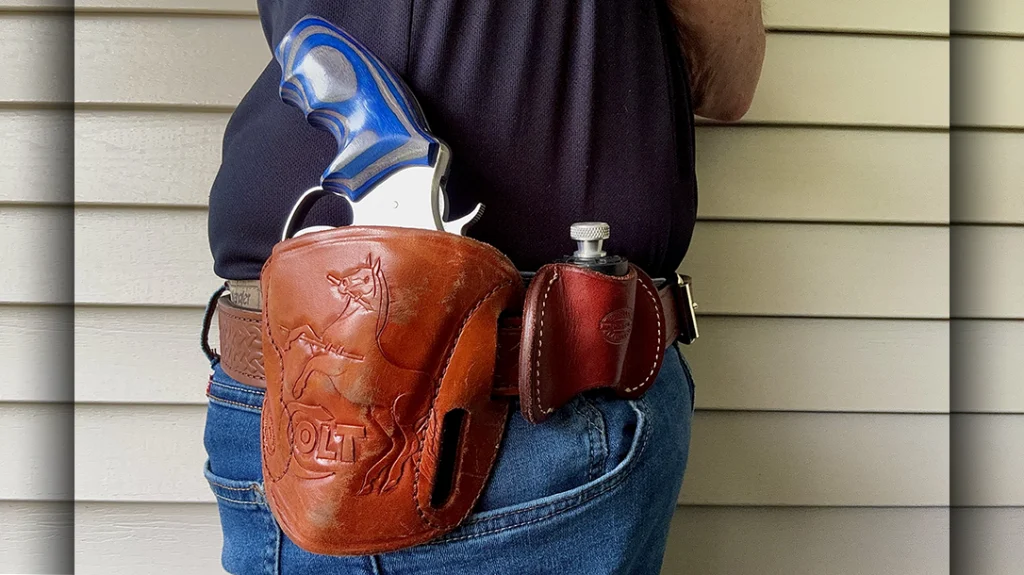
Advertisement — Continue Reading Below
For a fast reload, I used an HKS Model 10-A speedloader. I carried it in a Barranti Spare leather speedloader pouch. It is another open-top design with two 1.5-inch belt slots in a brown finish.
I’ll confess: When I first picked up the Viper, I knew the factory walnut stocks’ configuration would make shooting painful. Specifically, because they pushed my middle finger against the trigger guard. This was confirmed with a few shots of the test ammunition.
I did some Web surfing and came up with some Cobra “Full Grips” from Badger Custom Grips. These are combat-style, with finger grooves and palm swells that taper toward the butt. They’re two-piece, laminated wood—mine was in Spectra-Ply Blue Angel coloration. They fit me like a glove and solved the injurious trigger guard issue.
Advertisement — Continue Reading Below
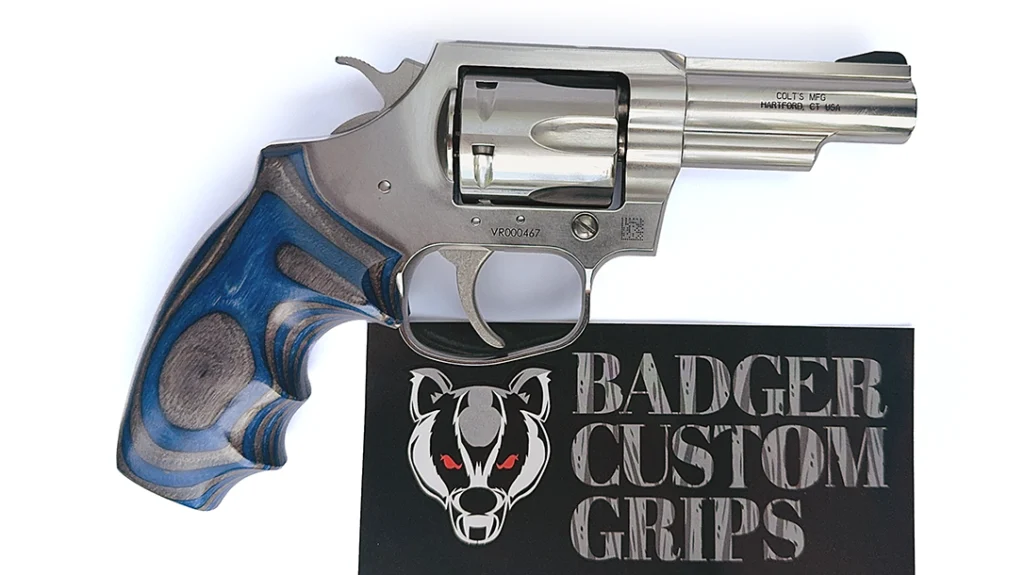
Viper Shootout
My test started with a chronograph session to measure bullet velocity out of the Viper’s 3-inch barrel. You can see the figures in the performance chart below. The biggest surprise was the Doubletap DT Lead-Free SC-HP .357 load—it’s a handful.
Unfortunately, it showed high-pressure signs with flat primers and swollen cases that stuck inside the chambers, making extraction difficult. This happened again during the accuracy evaluation. The lesson here is don’t fill your shooting iron with ammo you haven’t tested out beforehand!
Given the Viper’s short barrel and fixed sights, I decided to test its accuracy potential at 12 yards. Shooting was done in the SA mode from the bench using a sandbag rest. Three 5-shot groups were fired with each of the 5 test loads.
I rather expected one of the .38 Special loads to be the top performer. I was wrong. The tightest 5-shot cluster was made using the Federal Train + Protect .357 Magnum cartridges. It measured 1.17 inches and had a group average of 1.66 inches.
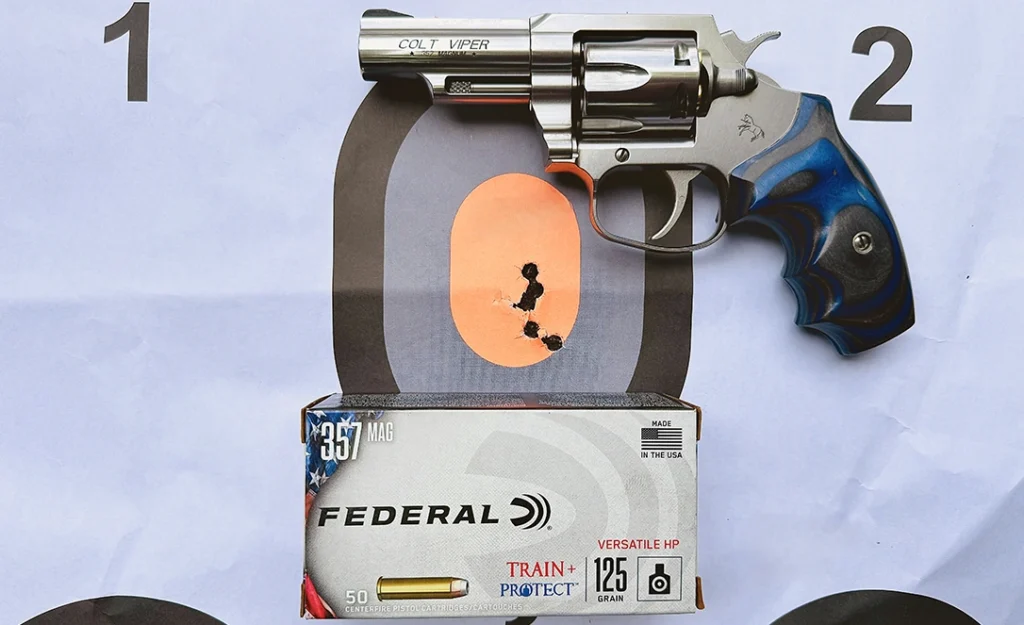
Second place went to the Black Hills .38 Special load with a 1.25-inch group. The point of aim/point of impact was good. For most of the test loads, I held the top of the front sight almost even with the orange center of the paper target.
50-Round Snub Workout
I wanted to try a practical shooting course I saw recently that’s called “50 Round Snub Workout – 6 Shot Guns.” This looked like the ideal test bed for the Colt Viper.
My septuagenarian hand/wrist/forearm has been giving me pain issues. So, I decided to shoot the course with the PPU .38 Special rounds that are like the old police service cartridges of yesteryear. The round-nose bullets also work best when using speedloaders.
With the Viper in my Simply Rugged holster and the HKS speedloader in my Barranti pouch, I stepped to the firing line. The course consists of eight phases, and the directions advise the shooter to “push the envelope,” firing as fast as possible while still achieving positive results.
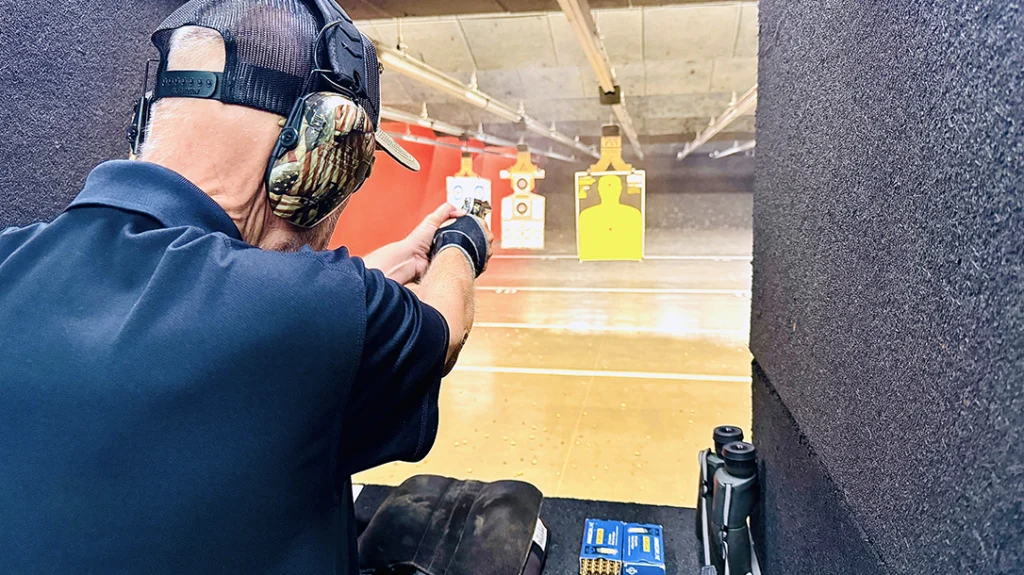
The first four phases are shot at 4 yards. First, primary hand, then support hand only, draw and fire 2 shots, 3X. Next is a failure drill, draw and fire 2 body and 1 headshot, 2X. Lastly, draw and fire 6 shots, 1X.
Phase 5 starts at 7 yards. Draw and fire 2 shots, 3X, primary hand only. Also, at 7 yards is a tactical reload. Draw and fire 2 shots, perform the reload with two rounds, do a threat assessment, and re-holster.
Phase 7 is an emergency reload drill. Draw and fire 3 rounds, 2X, reload, then do 2 more triple-taps. Phase 8 is at 15 yards. Draw and fire 2 shots, standing or kneeling (I did both), 3X.
Damage Assessment
The directions for the Snub Workout course said to use a realistic-size target with a high-scoring area. I dug through my supply of targets and came up with a Thompson Center-Fire Defender target. It has a yellow silhouette and 5- to 10-point scoring rings, with a red X-ring. The head has 10- and 15-point scoring rings and a red X-ring.
Par for the course was 510 points, with the target I was using. My score was 446-3X’s. None of the shots landed outside the 5-ring, and I was proud to see both of my headshots were 15-pointers.
This course will help you to discover your limitations. Best of all, the Colt Viper ran just fine with the PPU .38 Special ammunition. My reloading went well, and the sights were easy to acquire. There were no malfunctions or issues (except the aforementioned) during the T&E.
Kudus to the Badger Custom Grips and the nicely rounded cylinder release latch on the Viper. My right paw received no damage during the shooting.
I like the simplicity of a revolver and often recommend one to a beginning handgunner. The new Colt Viper would most certainly meet the criteria for my list of favorites.
For more information, please visit Colt.com.
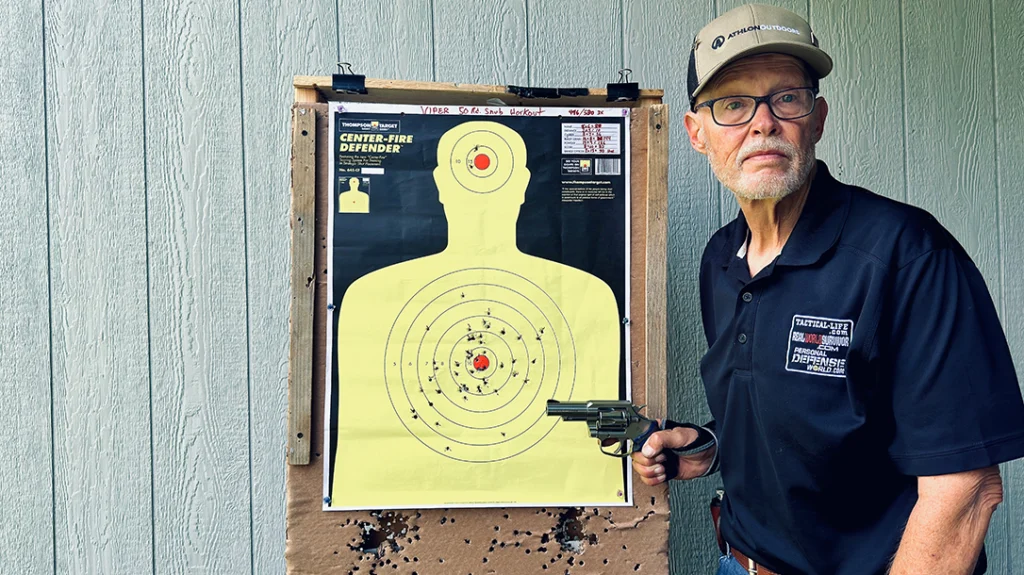
Colt Viper .357 Magnum Specs
| Mechanism | Traditional DA/SA revolver |
| Caliber | .357 Magnum/.38 Special +P |
| Capacity | 6 cartridges |
| Barrel | 3 in. (4.25 in. also available) |
| Overall Length | 7.92 in. |
| Empty Weight | 26.9 oz. |
| Sights | Black ramp front, fixed rear square-notch |
| Finish | Stainless steel |
| Stocks | Checkered two-piece walnut |
| MSRP | $999.00 |
Performance
| Cartridge | Ave. Velocity | Best Grp. | Ave. Grp. | Ft-Pounds Muzzle Energy |
| Black Hills Factory New .38 Special +P 125 gr. JHP | 938 FPS | 1.25” | 2.03” | 244 FPE |
| Doubletap Ammunition .357 Mag. 110 gr. Lead-Free SC-HP | 1557 FPS | 1.89” | 2.80” | 592 FPE |
| Federal Train + Protect .357 Mag. 125 gr. V-JHP | 1299 FPS | 1.17” | 1.66” | 468 FPE |
| PPU Handgun Line .38 Special 158 gr. RNL | 780 FPS | 2.33” | 2.68” | 214 FPE |
| Remington HTP .38 Special +P 125 gr. Semi-JHP | 1004 FPS | 2.24” | 2.41” | 280 FPE |
NOTE: Bullet weight measured in grains, velocity in feet per second 10 ft. from the muzzle by an Oehler Model 35P chronograph, and accuracy in inches for three 5-shot groups at 12 yards. FPE based on bullet weight and velocity.
